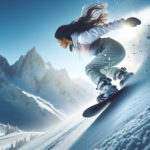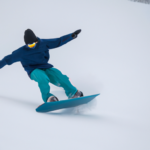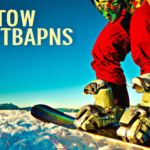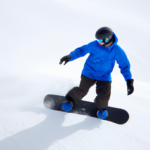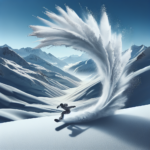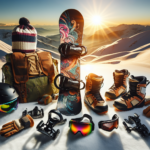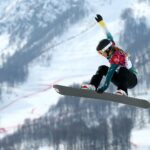Thinking about learning to snowboard? Great choice! This guide provides all the essential information that you’re going to be needing. Everything from finding the right equipment to mastering your balance and controlling your speeds on different terrains. It’s a thrilling ride ahead, so buckle up as you embark on this exhilarating journey to become a proficient snowboarder. Your snow-capped adventure starts here!”
Understand the Basics of Snowboarding
We all have to start somewhere. In your journey of learning how to snowboard, the first steps involve understanding the fundamentals. Knowledge is power, and this principle is the same in snowboarding.
Know What Snowboarding Is
Snowboarding is a winter sport that involves descending a slope covered in snow on a single board attached to the rider’s boots. But it’s far much more than that; it’s a masterful blend of precision, balance, and control. It’s a way of life for some, a thrilling hobby for others, and a fun-filled activity in the winter season. It’s about the exhilaration of being one with nature and enjoying the thrill of speed, execution, and control.
Understand the Gear Needed for Snowboarding
Before you hit the slopes, there are essential pieces of gear you need. The most critical gear includes a snowboard, bindings, snowboarding boots, winter clothing, goggles, gloves, and a helmet. Each piece of equipment plays a vital role in not only enhancing your performance but ensuring you are safe on the slopes.
Learn the Terminology of Snowboarding
Like any other sport, snowboarding has its own set of jargons. Terms like carving, freestyle, goofy, regular, and goofy stance, terrain park, piste, and many others are common in the snowboarding world. Understanding these terms will make your snowboarding journey smooth and enjoyable.
Choosing the Right Snowboarding Gear
Proper gear can make or break your snowboarding experience. Ensuring you have the right equipment is not just about your physical comfort but also your safety and performance on the slopes.
Buying vs. Renting Gear
If you’re new to snowboarding, you might want to consider renting gear initially. It’s cost-effective, and it also allows you to try out different equipment to know what suits you best. As you progress and get more serious about the sport, that’ll be the ideal time to invest in your own equipment.
Choosing the Correct Snowboard
Selecting the right snowboard is key to your snowboarding success. Consider factors like your weight, height, skill level, and the type of snowboarding you plan to do. For beginners, it’s usually best to start with an all-mountain board that’s user-friendly.
Selecting Suitable Snowboard Boots
Snowboard boots should provide a perfect combination of comfort and performance. They should be comfortable enough for you to wear all day, but also stiff enough to transfer energy to your snowboard.
Finding the Right Bindings
Bindings secure your boots to the snowboard and transfer your movement to the board. They should fit your boots perfectly and be suitable for your type of riding. Adjustability, comfort, and durability are some of the factors to consider when choosing bindings.
Picking Appropriate Outerwear
When choosing your outfit, consider the weather conditions. Your clothes should be warm, waterproof, and breathable. Good snowboarding clothing includes a base layer, an insulating layer, and a protective outer layer.
Understanding Snowboarding Safety Precactions
Snowboarding is a fun and thrilling sport, but it’s not without risks. Understanding and implementing safety precautions is vital to protect yourself from potential injuries and accidents.
Knowing the Dangers of Snowboarding
Snowboarding can lead to injuries like broken bones, concussions, and sprains if not done correctly. The key is to understand the risks, use protective gear, and learn the proper techniques to minimize these instances.
Dressing Safely for Snowboarding
Wearing the right gear is a critical safety measure. This includes a helmet to protect your head, wrist guards to cushion a fall on your hands, and padded shorts to protect your tailbone. Goggles help protect your eyes from snow and UV rays, while the right clothing keeps you warm in freezing conditions.
Recognizing the Signs of Hypothermia and Frostbite
By virtue of being a winter sport, snowboarding comes with risks of hypothermia and frostbite. Recognizing early signs like shivering, numbness, fatigue, shallow breathing, confusion, among others, is vital. if you observe these signs in yourself or others, it’s crucial to seek immediate help.
Following Slope Etiquette
Slope etiquette is an unwritten rulebook that ensures everyone’s safety on the slopes. It includes principles like not stopping in the middle of a slope, always downhill snowboarders having the right of way, and keeping a safe distance from others.
Taking a Safety Course or Lessons
Safety courses teach the fundamentals of how to snowboard safely. They cover everything from how to fall safely, slope etiquette, and what to do in case of an accident. If you’re new to snowboarding, investing in a safety course or lessons would be an excellent start.
Learning Basic Snowboarding Techniques
Before you can conquer the slopes, mastering the basic techniques is critical. These techniques will form the foundation of your snowboarding skills.
Practicing Standing and Balancing on a Snowboard
Balancing is one of the first skills you’ll need to master. Practice standing on your board while it’s still, then gradually progress to moving on a gentle gradient.
Learning to Slide Downhill
Sliding downhill is a skill that every snowboarder must master. Start on a small, gentle slope and learn the basic stance and weight distribution necessary for sliding downhill.
Mastering Turning and Stopping Techniques
Knowing when and how to turn and stop is critical in snowboarding. Practice different turning techniques and experiment with different ways to stop until you become comfortable executing these maneuvers.
Mastering Falling and Getting Up Again
In snowboarding, falling is part of the learning process. It’s not about whether you fall, but how you fall and get back up that matters.
Understanding the correct way to Fall
When a fall is inevitable, knowing how to do it right can minimize injury. The key is to keep your body relaxed and try to land on your forearm and shoulder instead of trying to catch yourself with your hands.
Techniques for Getting up Quickly and Safely
Mastering the art of getting up quickly and safely after a fall can help you regain your momentum and rhythm in no time. The technique to get up varies depending on whether you’re facing downhill or uphill.
Overcoming fear of Falling
Fear of falling can hinder your progress in snowboarding. It’s crucial to understand that falling is part of the learning process and it’s through your falls you actually grow as a snowboarder.
Finding the Right Snowboarding Instructor or Course
The right instruction can drastically speed up your learning process and refine your snowboarding skills.
Determining the Type of Instruction You Need
The type of instruction you need depends on your skill level, learning style, budget, and personal goals. You could opt for private lessons, group classes, or online tutorials.
Finding an Instructor or Course that Suits your Needs
A good instructor is patient, experienced, certified, and understands your goals. Take your time to research, ask for recommendations, and try out a few classes before deciding.
Understanding the Costs and Time Commitment for Lessons
Snowboarding lessons are an investment in terms of money and time. Understanding the commitment required in both aspects will help you manage your expectations and get the most out of your lessons.
Practicing Your Skills on Various Terrains
Once you’ve learnt the basics, it’s time to put your skills into practice. The different terrains offer unique challenges and experiences that help you become a well-rounded snowboarder.
Starting with Beginner Slopes
Beginner slopes offer the perfect platform to practice your basic skills. They are wide, open and have a gentle gradient, making it an ideal place to practice turning, stopping and controlling your speed.
Progressing to More Difficult Runs
As your confidence and abilities grow, challenge yourself on more difficult runs. They’re steeper and narrower, requiring higher levels of precision, control, and speed.
Trying Out the Snow Park
Snow parks offer various features like jumps, half-pipes, boxes, and rails for freestyle snowboarding. It’s an exciting way to mix up your snowboarding experience.
Venturing into Off-Piste Snowboarding
Off-piste snowboarding refers to riding on unmarked or unpatrolled areas outside the designated slopes. It appeals to advanced snowboarders seeking a unique, challenging experience. Always remember, safety comes first; venture off-piste only when you’re confident of your skills, and never go alone.
Refining Your Snowboarding Style and Technique
As you snowboard more, you’ll start developing your style and technique. It’s about honing your strengths, perfecting your moves and pushing your limits.
Developing Your Own Snowboarding Style
Your style is a reflection of your personality and preference. It’s the way you stand, turn, slide, and even fall. Embrace your individuality and let it shine through your snowboarding style.
Increasing Your Speed and Agility
Speed and agility are the advanced skills that you refine with more practice and experience. Start slow, work on your balance, body rotation techniques, and gradually pick up speed.
Mastering Advanced Tricks and Manoeuvres
Once you’re comfortable with speed and agility, it’s time to try some tricks. Whether it’s a 180 jump, fakie, nosepress, or ollie, take a dare and get playful.
Maintain and Improve Your Snowboarding Fitness
Snowboarding is physically demanding, so it’s crucial to maintain and improve your fitness in order to enjoy and perform at your best on the slopes.
Exercises to Improve Strength and Flexibility for Snowboarding
Strength and flexibility are the keys to better performance and fewer injuries. Incorporate workouts focused on building leg strength, core stability, and flexibility in your routine.
Nutrition and Hydration for Snowboarding
Nutrition and hydration play a critical role in your performance and recovery. Stay hydrated on the slopes, and fuel your body pre- and post-snowboarding with balanced meals.
Rest and Recovery Strategies
Proper rest and recovery are just as important as active training. Sleep, gentle stretching, and rest days are essential for muscle recovery and overall wellness.
Joining a Snowboarding Community
Joining a community of fellow snowboarders can add a whole new level of enjoyment to your snowboarding experience.
Networking with Other Snowboarders
Networking with other snowboarders allows you to share experiences, learn from each other, and gain new snowboarding buddies.
Participating in Snowboarding Events
Participating in events is a fun way to challenge yourself, showcase your skills, and meet like-minded people. This could be a local competition, a snowboarding festival, or a fun race.
Joining Snowboarding Clubs or Associations
Joining clubs or associations offers structured experiences like regular meetups, training sessions, and tours. It’s a wonderful place to learn, connect, and grow in the snowboarding world.
Continuing to Learn and Grow in the Snowboarding Community
Snowboarding is a journey of continuous learning and growth. Embrace this journey, savour every moment on the slopes, and keep exploring the beautiful world of snowboarding. By doing this, you’re not only mastering snowboarding but also creating lifelong memories and friendships.
- What Snowboard Bindings Should I Get? - January 23, 2024
- What Size Screws For Snowboard Bindings? - January 23, 2024
- How To Snowmobile On Water? - January 23, 2024

